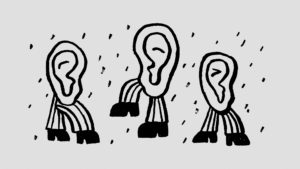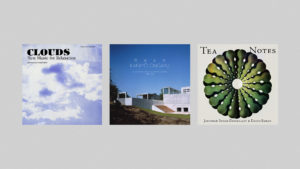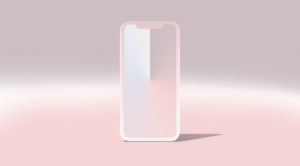
Pardon the Interruption — Sound
Faced with a flood of media seeking to make sense of the new reality unfolding before us, one begins to feel like a game show contestant blindly grabbing for money fluttering around a wind-tunnel: overwhelmed with options but unable to grasp anything concrete. Instead of contributing another voice to the noise, and ultimately, the confusion, we at Athletics are curious to map out some of the subtler, more personally resonant regions of this evolving world order. This is the premise of Pardon the Interruption: our ongoing meditation on new textures of life emerging in the age of coronavirus. It is our hope that we might extract some measure of optimism from this immeasurable experience, like wringing a single gallon of syrup from 40 gallons of bitter sap. In this first installment, our resident writer and strategist Zander Abranowicz explores the role of sound in our lived experience, and considers the ways in which sound dictates our present sense of distance.
Designing with two ears
My parents are walking encyclopedias of jingles, prone to cringe-worthy performances of hokey 60s and 70s advertisements at the dinner table: “Schaeffer is the one beer to have when you’re having more than one! Schaeffer pleasure doesn’t fade even when your thirst is done!” Jingles are a primitive form of what today is known as “sonic branding.” According to Marsha Appel, SVP of 4A’s Research Group, a sonic brand is “an aural mnemonic device, a shortcut to embed a brand identity in consumer’s minds and trigger immediate brand recall.” In the time of smart speakers, podcasts, mobile payments, and other contactless interactions where visual symbols and written text cannot reinforce relationships, sound is an essential building block of strong brands, on par with color, type, UX, and messaging. As creatives, we deal in all five senses, but hearing holds a special place in our DNA, unsurprising given the musical origins of our leadership. Creative Director Malcolm Buick began his career in London designing album covers for groups like Groove Armada, Everything But The Girl, and Paul Oakenfold. Creative and Project Lead Matt Owens was a fixture of the Austin hardcore scene and ran the independent punk record label The Buddy System for over a decade. Creative Director Jason Gnewikow toured the world as lead guitarist for indie rock band The Promise Ring and cut records with J Robbins, Mario Caldato, Jr. (Beastie Boys, Beck), and Stephen Street (Smiths, Moz, Blur). Digital Strategy Director Jameson Proctor played guitar, keys, and sang in a series of country rock and garage bands. As Jason stated in a 2017 interview with The Creative Independent, “It all comes from the same impulse, whether it’s writing a song or making a perfume or creating a piece of graphic design or developing a concept — they’re all the same thing.” This persuasion is reflected in our projects, from designing a suite of sounds for the Xbox 360 in our early days, to our current collaboration with Simon Pyke of WARP records to create a sonic score for the brand relaunch of tech company Citrix. We’ve always been drawn to music-oriented clients, from venues like Terminal 5 and Brooklyn Steel, to early education programs like Music Together, to brick and mortar synthesizer shops like Control, and even music-inspired sports teams like Nashville Soccer Club. This is all to say, we’re acutely aware of the role listening plays in our experience of the world, and often use audio as a powerful albeit invisible force to shape the experiences we create for others.

Open your ears
When I was in high school, a family friend staying at our house told me we were losing our ancient connection to sound. This was at the height of iPod mania, and this friend, a nomadic artist who traveled the world making field recordings, was concerned that with more and more people spending the majority of their waking lives wearing headphones — increasingly of the noise-cancelling variety — we as a species were forgetting the power of sound to ground us and guide us, but perhaps most importantly, to create space for thinking. This idea has always stuck with me, and in the intervening years I’ve sought to focus on the acoustic environments where I dwell. Just as we process visual scenery, so do we process sonic scenery, or, as that poet laureate of sound Brian Eno has called them, “sonic landscapes.” (It is no coincidence that Sonic Landscapes was the title of my college radio show). Consider the sonic landscape of everyday life before shelter in place. The rush of a shower, the pleasant chatter of WNYC, the whistle of a kettle, the ripple of freshly-boiled water filtering through coffee grounds, the rattle of the R and G trains, the pitter patter of typing on a Macbook keyboard, the sizzle of something cooking over the stove, the wail of police sirens, the moan of a blues record on the turntable, the purr of a cat settling at the end of the bed: these were my “comfort sounds,” bringing rhythm and structure to my days. But every city is a sensory battlefield, and New York especially so, with new auditory assaults ambushing us at every degree of decibel, from a percussive gathering at Drummer’s Grove in Prospect Park, to a battalion of motorcyclists storming through a quiet neighborhood, to a power drill pulverizing concrete at a dusty construction site. And of course, each season brings its own aural palette: the clamor of a summer afternoon, the clarity of an autumn morning, the muffled surfaces of a winter blizzard, the songs of spring. Even the most transcendent music composed or performed by human hands pales in comparison to the natural world. As the Scottish naturalist and legendary listener John Muir once mused: “Who publishes the sheet-music of the winds, or the written music of water written in river-lines?”
Sonic distancing
Athletics has its own distinct auditory profile. Massive Attack plays quietly on the stereo. The water filter dispenses freshly-carbonated seltzer, then recharges. A meeting in the conference room modulates between quiet conversation and laughter. The printer churns out warm leafs of paper, pleasantly humming while it works. Developers gathered around a desk unravel their latest riddle in code. Someone (everyone at Athletics knows who I’m referring to) breaks into improvised song when it’s time to brew a fresh pot of tea. With the team now working from home, we find ourselves far from the sounds of our studio. While I rely on silence to write, often retreating into my Bose headphones for quiet, the absence of these familiar noises is a potent reminder of our collective distance. I’m not alone in this feeling: in his recent newsletter the tech analyst Benedict Evans recommended The Sounds of the Office (Smithsonian Folkways, 1964), featuring tracks like “Heat Copyer (Thermofax) and Stapling,” “Bookkeeping Machine,” and “Coffee Break,” for those of us missing the familiarity of an office atmosphere. As it happens, Athletics is using sound to stick together through the pandemic, both unconsciously and consciously. Unconsciously, we hear each other’s voices through Zoom, Slack, or Google Hangouts. And consciously, we’ve set up a Slack channel (#hotmixes) for the express purpose of sharing music. After all, sharing music is a sign of real affection: how many of us have created mixes for loved ones over the years? Sound can be a measure of distance, but also a bridge across time and space.
The new sensorium
Having considered the sonic landscape of yesterday and the ways in which it’s evolved since the start of the crisis, I’d like to map out the territory I’m inhabiting now. At my desk in our house in the Catskill mountains, I’ve been gravitating toward a specific subset of my music collection: minimalist albums like “Clouds: Music for Relaxation,” “Kankyo Ongaku: Japanese Ambient, Environmental & New Age Music 1980-1990,” and “Tea Notes.” Marrying man-made sounds with field recordings, these spare compositions often have no discernible rhythm or melody, or titanically slow forms of both. In them, I’m finding a sanctuary I can enter when the noise level in my workspace (shared with five others) becomes untenable.

Midday, I break for a 30-minute sound meditation with the help of Non, an app designed by Athletics friend and collaborator John Soat and his creative partnership Point in Passing. (Disclaimer: I provided the project’s copy and messaging). Using generative — not pre-recorded — compositions to invite active listening, Non invites me to approach each session unclouded by expectation, like presenting a new path for exploration each day. If these sequences of sound are pathways, drifting thoughts are forks in the road, tempting me with distraction. With practice I’ve learned to walk the line, returning to Non’s hypnotic soundscapes when my thoughts drift, and renouncing control of consciousness if only for a moment. The result is a 30-minute respite from the worries and anxieties naturally emerging at this time of global — and personal — uncertainty. In the evening I take an hour-long walk in the woods surrounding our house, focusing on the sounds around me with the same intent as a sound meditation. Over a month and a half, I’ve listened to heavy rain on the surface of a pond, the passing of wind through conifers, the hollow thump of snow falling from a branch, the chirping of a brook weaving through wild mint, the growling thunder of an early spring storm, and the songs of non-migratory birds in the canopy. When the work day is done, I have the privilege of tuning in to these daily broadcasts of nature. In each of these activities, I see opportunities to make peace with this often-frightening moment of human history. My olive branches are music, meditation, and the sound of wind through trees.

Learning to listen
What will the world sound like when quarantine ends? Will the subway be especially shrill? Will the din of a party be overwhelming? Will the steaming of an espresso machine in my favorite café be as sweet as I imagine? These questions have been popping into my head as I’ve written this piece over the past few days. For now, I’ve decided to simply try and listen to what this moment has to say. Without commutes and daily contact with the manic pace of our city, my very tempo of life has slowed. I’m determined not to occupy every downbeat with static, but rather to seek beauty in the silences in-between. Perhaps it’s in those moments that the earth speaks to us. I’m trying to listen, and in listening, learn. For Athletics, this is a critical testing period, measuring our aptitude in that core component of good communication: listening. Listening to one another, to our clients, to their audiences, to the market, to our peers in the creative industry. We’re trying to listen, and in listening, grow.